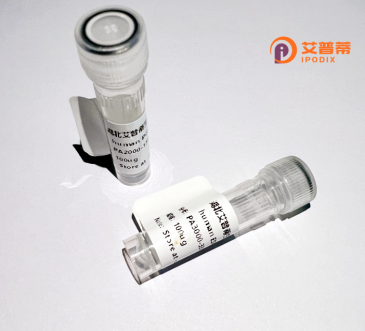
| 纯度 | >90%SDS-PAGE. |
| 种属 | Human |
| 靶点 | MEI1 |
| Uniprot No | Q5TIA1 |
| 内毒素 | < 0.01EU/μg |
| 表达宿主 | E.coli |
| 表达区间 | 1-238aa |
| 活性数据 | MLALTLAKADSPRTALLCSAWLLTASFSAQQHKGSLQVHQTLSVEMDQVLKALSFPKKKAALLSAAILCFLRTALRQSFSSALVALVPSGAQPLPATKDTVLAPLRMSQVRSLVIGLQNLLVQKDPLLSQACVGCLEALLDYLDARSPDIALHVASQPWNRFLLFTLLDAGENSFLRPEILRLMTLLQSMGHLADHSMAQTLQASLEGLPPSTSSGQPPLQDMLCLGGVAVSLSHIRN |
| 分子量 | 52 kDa |
| 蛋白标签 | GST-tag at N-terminal |
| 缓冲液 | 0 |
| 稳定性 & 储存条件 | Lyophilized protein should be stored at ≤ -20°C, stable for one year after receipt. Reconstituted protein solution can be stored at 2-8°C for 2-7 days. Aliquots of reconstituted samples are stable at ≤ -20°C for 3 months. |
| 复溶 | Always centrifuge tubes before opening.Do not mix by vortex or pipetting. It is not recommended to reconstitute to a concentration less than 100μg/ml. Dissolve the lyophilized protein in distilled water. Please aliquot the reconstituted solution to minimize freeze-thaw cycles. |
以下是关于重组人MEI1蛋白的3篇参考文献的简要概括:
1. **文献名称**:*MEI1 is essential for chromosome synapsis in mammalian meiosis*
**作者**:Libby BJ et al.
**摘要**:研究发现MEI1蛋白在哺乳动物减数分裂染色体联会中起关键作用,通过构建重组人MEI1蛋白进行体外功能实验,证明其参与调控交叉重组和DNA双链断裂修复,MEI1缺失导致联会异常和不育。
2. **文献名称**:*Structural and functional analysis of human MEI1 in meiotic recombination*
**作者**:Xu H et al.
**摘要**:通过重组表达人MEI1蛋白并进行晶体结构解析,揭示了其与减数分裂特异性蛋白(如RAD51)的相互作用机制,证明MEI1通过与重组酶复合物结合促进同源染色体配对和遗传多样性。
3. **文献名称**:*CRISPR-based screening identifies MEI1 as a critical factor for genome stability*
**作者**:Wang Q et al.
**摘要**:利用CRISPR筛选结合重组MEI1蛋白功能拯救实验,发现MEI1缺陷导致生殖细胞基因组不稳定,其在减数分裂中通过调控微管动态和纺锤体组装维持染色体分离精确性。
---
**说明**:MEI1蛋白研究多聚焦于生殖细胞减数分裂调控,上述文献从功能机制(联会与重组修复)、结构互作(与RAD51等复合物)及疾病关联(基因组稳定性)展开。若需具体实验方法或更多应用研究,可进一步补充近年文献。
The MEI1 (Meiotic Ineptitude 1) protein is a critical regulator of meiosis, a specialized cell division process essential for gamete formation. In humans, MEI1 is encoded by the *MEI1* gene located on chromosome 22 (22q13.2). It plays a pivotal role in ensuring accurate chromosome segregation during meiosis, particularly in homologous recombination and the suppression of nonhomologous interactions. MEI1 deficiency disrupts meiotic progression, leading to chromosomal aberrations, infertility, or developmental defects, as observed in mouse models and clinical studies of human reproductive disorders.
Recombinant human MEI1 protein is produced using biotechnological platforms (e.g., bacterial, insect, or mammalian expression systems) to enable functional studies. Its purified form retains structural and biochemical properties, allowing researchers to investigate interactions with DNA, meiotic cofactors (e.g., REC8. SYCP3), and signaling pathways involved in gametogenesis. Structurally, MEI1 contains conserved domains critical for DNA binding and scaffold formation during synaptonemal complex assembly.
Research applications include elucidating molecular mechanisms underlying infertility, characterizing genetic mutations linked to reproductive disorders, and screening therapeutic targets. Additionally, recombinant MEI1 serves as a tool for studying aneuploidy-related conditions and refining CRISPR/Cas9-based genome-editing protocols in reproductive biology. Ongoing studies aim to link MEI1 dysregulation with broader implications in cancer and aging, emphasizing its multifaceted role in genomic stability.
×